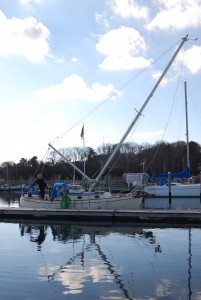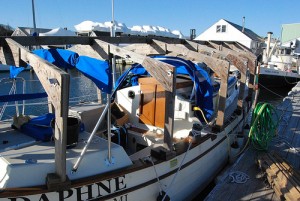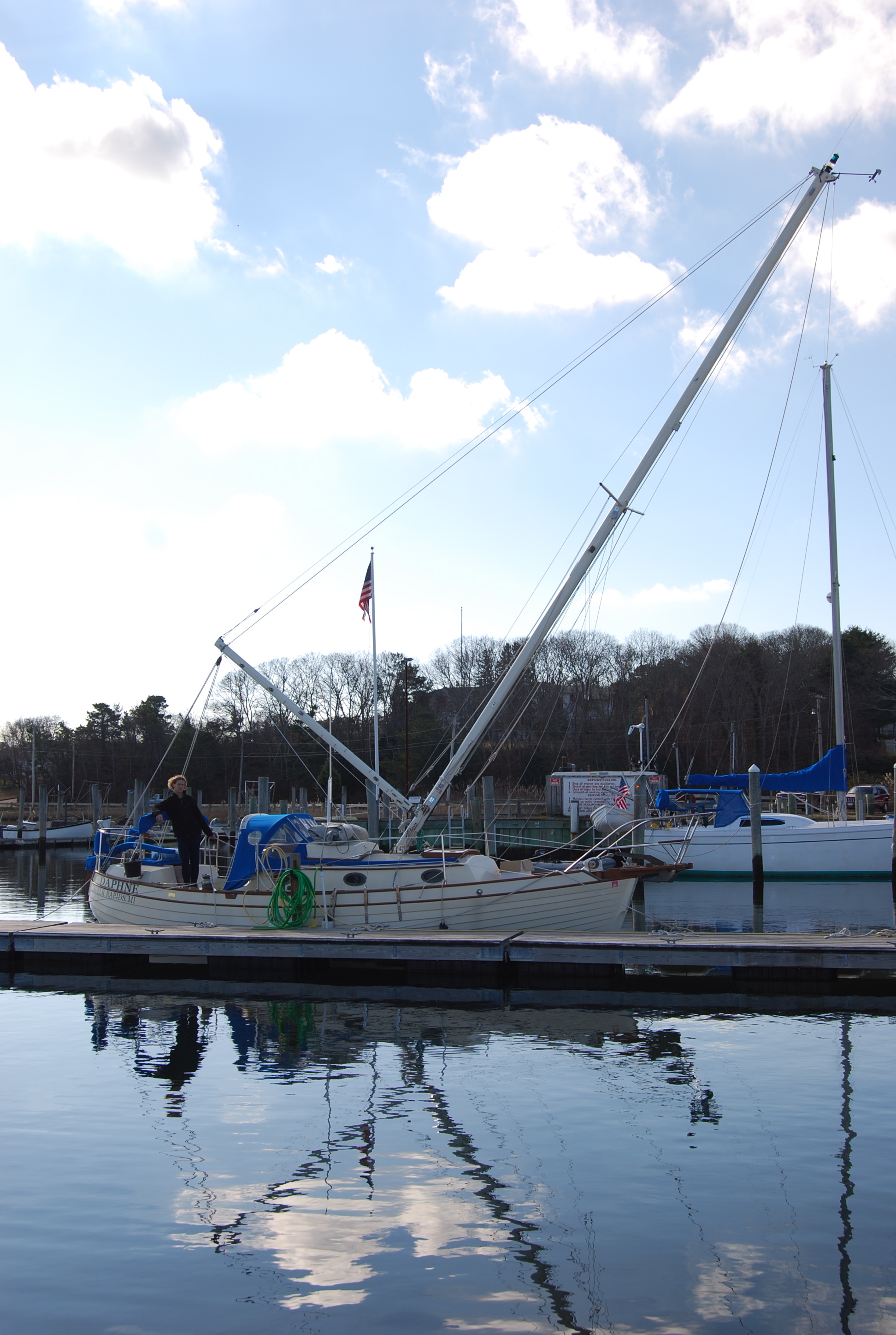 This weekend I began the process of getting my boat ready for winter. First, with the help of a few friends, I lowered the mast and moved it off the boat. The next step was to put the cover on. I put a wood frame over the entire boat from bow to stern. It looked like ribs on a whale lying belly up in the water. For most of this I had Benji’s help, but when it came time to put the cover on, I was on my own.
This weekend I began the process of getting my boat ready for winter. First, with the help of a few friends, I lowered the mast and moved it off the boat. The next step was to put the cover on. I put a wood frame over the entire boat from bow to stern. It looked like ribs on a whale lying belly up in the water. For most of this I had Benji’s help, but when it came time to put the cover on, I was on my own.
I began at the bow and unrolled the giant piece of heavy canvas. The water was still and the air was calm. It was the perfect day for this project. I worked steadily, but at a slow pace. Thrice a piece of the cover blew into the ocean and I had to fish it out of the icy water.
By the time I had most of the cover on the wind had kicked up. I had been holding tight to the cover during the gusts and quickly lashing it down during the lulls. But by mid-afternoon there were no lulls. It was windy. Steady strong winds. I held on tight and gripping the cover I felt like I was going to be lifted off the boat and blown into the air. It was only by luck (and an extra hand) that I was able to complete the task. Then, onto the next.
The moisture that is produced through condensation on the inside of my hull has become a problem in my lockers where I store many things. I only have a few items and in the lockers they were getting to wet and mildew was growing on them. The insulation that I lined the lockers with wasn’t enough. Instead of preventing the warm interior air from hitting the cold hull and condensing into water droplets or even ice, it lands on my things and the insulation and condenses there.
I spent the rest of my weekend reorganizing and trying to find a solution to the problem. How could I simultaneously stay warm enough and not cause moisture in the lockers, when the amount of moisture is directly related to the disparity between heat outside and inside the boat? When it is colder outside, I turn my heat up and the condensation from the hot air hitting the icy hull is increased. Its a lose/lose situation.
Oh, of course I have sought advice and have tried many many things. But nothing has proven to be a reliable solution. If I had more options, I would store my things in an unheated space on the boat, or perhaps on shore. But my cabin is so small that it heats up entirely in less than five minutes and my shore options are limited. My only solution, for the time being, is to put everything into clear plastic bags.
And so begins my winter live-aboard life. I had foreseen a life very much like that of the summer, with a few extra layers. But the reality is much much different. Life aboard in the winter is more difficult. The cold and reduced sunlight are having a big impact on living comfortably and pursuing hobbies and daily tasks. Things that I often took for granted, such as a warm shower, blogging and checking email, exercise, Yoga, getting safely around town, warmth, clean laundry, etc. are now a challenge or uncomfortable. Having a friend who lives ashore is essential. I can’t wait for spring.



Comments 21
Good for you. I have felt all the emotions and anxiety and joy and calm that you are going through as you become a sailor. Of all the timany things I have done in my life spanning more than half a century, it is sailing which most defines me and where I go in my mind whenever I can, that is when I am not on the boat and on the water.
Owning only what you need to sail, and that is not a small amount, is simply the best. Who wants to be burdened by possessions and worrying about who to give what to.
Do you have any plans to set sail to distant shores (yet)?
Many people doing frames like that make it much lighter. Yours looks very sturdy and makes more sense to me. About the only issue I see for you is watching that you don’t get a build up of snow. Several hundred pounds of snow can make it tipsy! But you probably already thought of that. I’m from the South, so that’s novel thinking for me.
Nice job! Post some pictures of it with the cover on?
-dan
It’s good you are getting this done. Alas, my ignorance means I can’t really offer any advice re: condensation.
Take care,
J
http://adventuresinvoluntarysimplicity.blogspot.com/
For some excellent information on living aboard through extreme cold check out http://pagina.de/naomi.j go to the living aboard page there and you will find heaps of good stuff by someone who spent several winters aboard in the extreme winters of NORWAY! Owen, the writer professes to not like the cold and I would believe it. He now lives in St Martin. He frequents the SSCA forums under the user name LA7QZ.
Another thought on the condensation problems in you lockers. Do you have plenty of air flow through them? ie ventilation holes in the bottom and top of openings. You may have already addressed that issue, but you do need plenty of air flow through closed spaces.
How could I simultaneously stay warm enough and not cause moisture in the lockers, when the amount of moisture is directly related to the disparity between heat outside and inside the boat? When it is colder outside, I turn my heat up and the condensation from the hot air hitting the icy hull is increased. Its a lose/lose situation.
Well, this isn’t exactly correct. You get condensation when you bring air below its dew point, as at that point it is over-saturated. One way around this is precisely what you are trying to avoid, which is to heat the cabin entirely. That will have the effect of both bringing the air temperature up above its dew point as well as somewhat dehumidifying the cabin air. You are correct in that there is a boundary layer between above- and below dew point air, but if you have good air circulation and sufficient heat, that boundary should lie outside the hull. Of course, that means you may find external ice forming on the coldest of days, but that shouldn’t be much of a problem as it is in plain view outside and not hidden (say) behind lockers….
Hey Teresa, just thought I would check back in, glad to see your still getting along with it all :). I see that your still smiling in the picture above, thats a good sign lol. Mybe in the spring you can head down south here were it is a bit warmer in the winters, in the 70’s here in florida :). Well take care and the best of luck.
Steve. Living on Sasi, were it is warm lol, sorry I had to rub it in, take care silly 🙂
Teresa,
Just discovered your blog this morning and enjoyed reading all the entries to date. I recently retired, after 29 years, from the Navy and am currently residing on Cape Cod restoring a house. Your escape after a New England winter will have been well earned and I would think make the joy of getting underway that much more exhilarating. One day at a time. Peter
What does a ship say when it is cold….
“Shiver me timbers!”
Hello,
My wife and I have wintered over in what I suspect is a milder climate in Maryland. I’m not sure where you are, but a cover like yours is over kill here. But we have the same problems with condensation. Like another said you must keep every surface above the dew point temperature. I believe the keys are insulation and ventilation. Every locker needs to have enough insulation to allow the warm ventilated air entering to keep all surface temperatures above the dew point. I’m thinking of using some old computer fans to move air to more remote corners of the boat. With a catamarans two hulls I’ve got twice the problem distributing the warm air. But plastic bags and Lysol go a long way to help.
Best of luck
Ed
T-
I am sure you can make it! You made it through Grad school! You can do anything. This is a cool little website you have going! I look forward to checking it out more often. Stay as toasty as you can and have a great Holiday.
P.S. I know you have your cat, but you might want to look into a dog – they are bigger and offer more warmth!
-Becky
Your blog is great. I feel very inspired by it. I have never had much interest in boats or the ocean living in Colorado most of my life, but after reading your blog I caught myself looking for sail boats that were for sale when I was exploring San Francisco and Marin County the other day. I really want to learn sailing all of a sudden. Keep up the good work.
-Ty
Hi Teresa, I think I’ve told you this before on a comment, but I really enjoy reading your posts when I stop by! I finally added you to the list of links on my page http://www.faliaphotography.com
I hope you are able to stay warm this winter,
I really think what you are doing is terrific.
Sonja
How are you holding up with this weather????
Having spent 2 winters on my Cape Dory 30 on the Chicago River, I offer the following:
1. 2 electric blankets (1 under the sheet, 1 over you)
2. 2 small heaters
3. 1 small shovel (to clear the dock and the cockpit
That’s it.
The 1st winter, there were 2 sailboats on the river; the 2nd winter, there was one – me. I didn’t have a cover over the boat – there were some interesting moments getting on the boat after 3-4 inches of snow.
Good luck with your journey,
Forrest
What kind of heater do you have? If you are just trying to heat the existing air in the hull without bringing in outside air, the humidity will continue to build up, which increases the dew point. You need to be heating cold outside air with an intake vent supplying the heater. When heated up, the relative humidity becomes very low and will expel the high humidity inside air to the outside. If you can some how vent to warm air from your heater to the far and inaccessible reaches of your hull, it will do a better job of keeping the overall humidity low.
You also need to keep the products of combustion from staying in the hull space which of course include the poison gases CO and Co2. It also includes water vapor which will increase your humidity if not vented (i.e. kerosene heater).
If your are using a gas or oil heater, it needs to be vented outside of your canvas cover and should receive outside combustion air from outside of the canvas cover.
If you are using heat, do not close up everything to conserve heat. Open your vents to exhaust high humidity (beyond your cover if possible) air venting in cold relative humidity air. These are the basic principles to keeping humidity low and have to be adapted for your conditions.
Love your blog!!!
Author
S, Dave,
I keep the hatch cracked open and two portlights open. When I use the kerosene, I open both hatches and the portlight right next to the heater. Trust me…I feel like I have tried every combination of ventilation, temperature, insulation, etc. I am at a loss and am just managing it until warmer weather arrives. The canvass cover is short on one side and falls about five inches above the gunwale, so that offers a bit more ventilation. I hope I’m in a snowless climate next winter. I just put the canvass cover on only a few days before I left for the holiday, and I haven’t noticed it making much difference. But I will try your tips, and the others offered here as well. I’ll keep trying until I get it right!
Thanks everyone!!!!
Pingback: Winter To-Do List
T –
I don’t have a bunch of time, so I’ll try and get it all on briefly.
As mentioned in previous posts, the condensation is due to air containing moisture cooling to its dew point (the temperature at which it no longer has the capacity to hold the moisture). This typically happens at cold surfaces… such is your problem.
The moisture is most likely due to you. In that small space, you’re breath and sweat are contributing to the moisture. If you’re cooking… same deal (sorry, haven’t kept up on blog enough to know how much cooking is happening in the boat… I think no showering, right? If so, that’s another source). In a house, this is typically dealt with using exhaust fans (i.e. bathroom and above range). Dealing with your sweat is a more difficult problem that you’ll just have to deal with.
SInce I can’t see the boat, I’ll let you try to figure it out. Controlling moisture at its source is most effective. GIve me a shout if you need any ideas.
V
Question. Do you have additional photos of lowering the on your boat? Why? Because I have a 28.5 Irwin which I need to lower the mast, my mast is mounted on tabernacle, but the lowering it, troubles me. I can see some of the rigging you had set-up.
Thanks for the writings.
I found a link here via “Live Aboard” web site. I am not quite there, living aboard, but soon.
Thanks,
Mitch
A byproduct of combustion is moisture. If the combusted air is not vented outside, which appears you don’t have a vent, the humidity level in the boat will continuously rise. If you want dry heat, you need to vent your heater, easier said than done, I know. Electric heaters do not produce moisture so if you have shore power, use them exclusively.